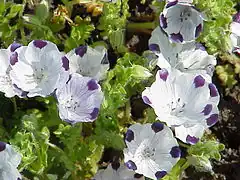Hydrophyllaceae
La famille des Hydrophyllacées regroupe des plantes dicotylédones. Selon Watson & Dallwitz elle comprend 250 espèces réparties en 17 genres. Ce sont principalement des plantes herbacées, annuelles, bisannuelles ou pérennes ou des arbustes parfois épineux largement répandus dans les régions tempérées à tropicales.

En France on rencontre la phacélie (Phacelia tanacetifolia), une plante mellifère annuelle, d'origine nord-américaine, à floraison bleue, cultivée comme couvert végétal sur les terres en jachère et qui s'est plus ou moins naturalisée.
Étymologie
Le nom vient du genre Hydrophyllum, composé des mots grecs Υδρο / Hydro, eau, et φύλλο / phyllo, feuille, littéralement « feuille d'eau ».
Classification
classification phylogénétique APG II (2003)[1], classification phylogénétique APG III (2009)[2], classification phylogénétique APG IV (2016)[3] gardent le genre Hydrolea dans l'ordre des Solanales et en font la famille des Hydroléacées et considèrent le reste des Hydrophyllacées comme une sous-famille des Boraginacées (qui est appelée Hydrophylloideae).
Il semble que de nombreux sites (BioLib, GRIN, NCBI, Tropicos) recommencent à considérer Hydrophyllaceae comme une famille valide.
Liste des genres
- Draperia
- Ellisia
- Emmenanthe
- Eriodictyon
- Eucrypta
- Hesperochiron
- Howellanthus
- Hydrolaea
- Hydrolea
- Hydrophyllum
- Nemophila
- Phacelia
- Pholistoma
- Reichelea
- Romanzoffia
- Romanzovia
- Romanzowia
- Tricardia
- Wigandia
- Draperia
- Ellisia
- Emmenanthe
- Eriodictyon
- Eucrypta
- Hesperochiron
- Howellanthus
- Hydrophyllum
- Nemophila
- Phacelia
- Pholistoma
- Romanzoffia
- Tricardia
- Draperia
- Ellisia
- Emmenanthe
- Eriodictyon
- Eucrypta
- Hesperochiron
- Hydrophyllum
- Nemophila
- Phacelia
- Pholistoma
- Romanzoffia
- Tricardia
Selon DELTA Angio (3 juin 2022)[7] :
- Codon
- Draperia
- Ellisia
- Emmenanthe
- Eriodictyon
- Eucrypta
- Hesperochiron
- Hydrolea
- Hydrophyllum
- Nama
- Nemophila
- Phacelia
- Pholistoma
- Romanzoffia
- Tricardia
- Turricula
- Wigandia
Voir aussi
Liens externes
- (en) Référence Flora of China : Hydrophyllaceae
- (en) Référence Flora of Pakistan : Hydrophyllaceae
- (en) Référence Flora of Missouri : Hydrophyllaceae
- (en) Référence Flora of Chile : Hydrophyllaceae
- (en) Référence DELTA Angio : Hydrophyllaceae
- (en) Référence Paleobiology Database : Hydrophyllaceae Brown
- (fr+en) Référence ITIS : Hydrophyllaceae
- (en) Référence NCBI : Hydrophyllaceae (taxons inclus)
- (en) Référence GRIN : famille Hydrophyllaceae R. Br. (+liste des genres contenant des synonymes)
- (en) Référence FloraBase (Australie-Occidentale) : classification Hydrophyllaceae
- (en) Angiosperm Phylogeny Group, « An update of the Angiosperm Phylogeny Group classification for the orders and families of flowering plants: APG II », Botanical Journal of the Linnean Society, Wiley-Blackwell, Linnean Society of London et OUP, vol. 141, no 4, , p. 399–436 (ISSN 0024-4074 et 1095-8339, DOI 10.1046/J.1095-8339.2003.T01-1-00158.X)
- (en) Angiosperm Phylogeny Group, « An update of the Angiosperm Phylogeny Group classification for the orders and families of flowering plants: APG III », Botanical Journal of the Linnean Society, Wiley-Blackwell, Linnean Society of London et OUP, vol. 161, no 2, , p. 105–121 (ISSN 0024-4074 et 1095-8339, DOI 10.1111/J.1095-8339.2009.00996.X)
- (en) Angiosperm Phylogeny Group, « An update of the Angiosperm Phylogeny Group classification for the orders and families of flowering plants: APG IV », Botanical Journal of the Linnean Society, Wiley-Blackwell, Linnean Society of London et OUP, vol. 181, no 1, , p. 1-20 (ISSN 0024-4074 et 1095-8339, DOI 10.1111/BOJ.12385)
- GBIF Secretariat. GBIF Backbone Taxonomy. Checklist dataset https://doi.org/10.15468/39omei accessed via GBIF.org, consulté le 3 juin 2022
- Integrated Taxonomic Information System (ITIS), www.itis.gov, CC0 https://doi.org/10.5066/F7KH0KBK, consulté le 3 juin 2022
- NCBI, consulté le 3 juin 2022
- DELTA Angio, consulté le 3 juin 2022